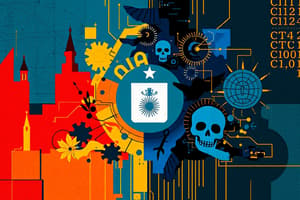Podcast
Questions and Answers
What does 'cyber' refer to in the context of cybersecurity?
What does 'cyber' refer to in the context of cybersecurity?
Anything connected to or involving the digital or networked environment, including systems, devices, networks, and data.
What are the three core components of the CIA Triad, essential for comprehensive cybersecurity?
What are the three core components of the CIA Triad, essential for comprehensive cybersecurity?
- Authentication, Authorization, and Accounting
- Vulnerability, Threat, and Risk
- Security, Privacy, and Control
- Confidentiality, Integrity, and Availability (correct)
Which of the following techniques is NOT used to achieve confidentiality?
Which of the following techniques is NOT used to achieve confidentiality?
- Hashing (correct)
- Biometric Authentication
- Encryption
- Access Control
Integrity ensures data is complete and accurate, even after unauthorized modifications.
Integrity ensures data is complete and accurate, even after unauthorized modifications.
What is the purpose of redundant systems in ensuring availability?
What is the purpose of redundant systems in ensuring availability?
Which of the following is NOT a common authentication mechanism?
Which of the following is NOT a common authentication mechanism?
What is the key difference between Role-Based Access Control (RBAC) and Mandatory Access Control (MAC)?
What is the key difference between Role-Based Access Control (RBAC) and Mandatory Access Control (MAC)?
Digital signatures are used for accountability and non-repudiation. They can prove that a specific individual or entity sent the message, preventing them from denying it.
Digital signatures are used for accountability and non-repudiation. They can prove that a specific individual or entity sent the message, preventing them from denying it.
What is the primary goal of implementing fault-tolerant methodologies in cybersecurity?
What is the primary goal of implementing fault-tolerant methodologies in cybersecurity?
Which of the following is NOT a key methodology used to achieve redundancy?
Which of the following is NOT a key methodology used to achieve redundancy?
What is the primary objective of intrusion detection and prevention systems (IDPS)?
What is the primary objective of intrusion detection and prevention systems (IDPS)?
The Bell-LaPadula Model is a formal model of security that primarily focuses on protecting data integrity by enforcing rules that prevent unauthorized modifications.
The Bell-LaPadula Model is a formal model of security that primarily focuses on protecting data integrity by enforcing rules that prevent unauthorized modifications.
What is steganography, and how does it differ from cryptography?
What is steganography, and how does it differ from cryptography?
How do firewalls enhance network security?
How do firewalls enhance network security?
Which of the following is NOT an example of a common cyber attack strategy?
Which of the following is NOT an example of a common cyber attack strategy?
What is a 'zero-day exploit'?
What is a 'zero-day exploit'?
What is the primary motivation behind most cybercriminal activities?
What is the primary motivation behind most cybercriminal activities?
What is the purpose of access control lists (ACLs) in operating system security?
What is the purpose of access control lists (ACLs) in operating system security?
The evolution of cybersecurity has led to a move towards more complex and sophisticated attacks, particularly with the emergence of AI-powered attacks.
The evolution of cybersecurity has led to a move towards more complex and sophisticated attacks, particularly with the emergence of AI-powered attacks.
What is the primary focus of the NIST Cybersecurity Framework (CSF)?
What is the primary focus of the NIST Cybersecurity Framework (CSF)?
Which of the following is NOT a key component of the ISO/IEC 27001 standard?
Which of the following is NOT a key component of the ISO/IEC 27001 standard?
What is the primary focus of the CIS Controls?
What is the primary focus of the CIS Controls?
COBIT is a framework specifically designed for managing payment card data security and compliance.
COBIT is a framework specifically designed for managing payment card data security and compliance.
What are the primary objectives of the PCI DSS standard?
What are the primary objectives of the PCI DSS standard?
The evolution of cyberattacks has transitioned from simple pranks and curiosity-driven actions to highly sophisticated, politically and economically motivated operations.
The evolution of cyberattacks has transitioned from simple pranks and curiosity-driven actions to highly sophisticated, politically and economically motivated operations.
What was the significance of the 'Morris Worm' in cybersecurity history?
What was the significance of the 'Morris Worm' in cybersecurity history?
Which of the following is NOT a characteristic of cyberattacks in the 1990s?
Which of the following is NOT a characteristic of cyberattacks in the 1990s?
What were some key characteristics of cyberattacks in the 2000s?
What were some key characteristics of cyberattacks in the 2000s?
Stuxnet was a ransomware attack targeting critical infrastructure, specifically nuclear enrichment facilities.
Stuxnet was a ransomware attack targeting critical infrastructure, specifically nuclear enrichment facilities.
What is the primary motivation behind Advanced Persistent Threats (APTs)?
What is the primary motivation behind Advanced Persistent Threats (APTs)?
What are some key trends and challenges in the future of cybersecurity?
What are some key trends and challenges in the future of cybersecurity?
Which of the following is NOT a key area of government regulation in the digital age?
Which of the following is NOT a key area of government regulation in the digital age?
What is the significance of the General Data Protection Regulation (GDPR)?
What is the significance of the General Data Protection Regulation (GDPR)?
Which of the following is NOT a key objective of the China's Cybersecurity Law?
Which of the following is NOT a key objective of the China's Cybersecurity Law?
What are some critical challenges associated with regulating artificial intelligence (AI)?
What are some critical challenges associated with regulating artificial intelligence (AI)?
The Digital Markets Act (DMA) focuses primarily on protecting consumers from illegal content and promoting transparency on large online platforms.
The Digital Markets Act (DMA) focuses primarily on protecting consumers from illegal content and promoting transparency on large online platforms.
What is the purpose of the Online Safety Bill in the United Kingdom?
What is the purpose of the Online Safety Bill in the United Kingdom?
What is the primary goal of intellectual property regulation in the digital age?
What is the primary goal of intellectual property regulation in the digital age?
Flashcards
Cybersecurity
Cybersecurity
The practice of protecting systems, networks, and programs from digital attacks.
CIA Triad
CIA Triad
A model that guides security policies for information security, focusing on Confidentiality, Integrity, and Availability.
Confidentiality
Confidentiality
Ensures that information is only accessible to authorized individuals.
Integrity
Integrity
Signup and view all the flashcards
Availability
Availability
Signup and view all the flashcards
Authentication
Authentication
Signup and view all the flashcards
Access Control
Access Control
Signup and view all the flashcards
Non-Repudiation
Non-Repudiation
Signup and view all the flashcards
Malware
Malware
Signup and view all the flashcards
Phishing
Phishing
Signup and view all the flashcards
Ransomware
Ransomware
Signup and view all the flashcards
DDoS Attack
DDoS Attack
Signup and view all the flashcards
SQL Injection
SQL Injection
Signup and view all the flashcards
Cryptography
Cryptography
Signup and view all the flashcards
Zero-Day Exploit
Zero-Day Exploit
Signup and view all the flashcards
Intrusion Detection System
Intrusion Detection System
Signup and view all the flashcards
Incident Response Plan
Incident Response Plan
Signup and view all the flashcards
Business Continuity Planning
Business Continuity Planning
Signup and view all the flashcards
Social Engineering
Social Engineering
Signup and view all the flashcards
Firewall
Firewall
Signup and view all the flashcards
Vulnerability Scanning
Vulnerability Scanning
Signup and view all the flashcards
Penetration Testing
Penetration Testing
Signup and view all the flashcards
Encryption
Encryption
Signup and view all the flashcards
Malicious Insider
Malicious Insider
Signup and view all the flashcards
Advanced Persistent Threat (APT)
Advanced Persistent Threat (APT)
Signup and view all the flashcards
Incident Response Team
Incident Response Team
Signup and view all the flashcards
Data Backup
Data Backup
Signup and view all the flashcards
Network Segmentation
Network Segmentation
Signup and view all the flashcards
Threat Intelligence
Threat Intelligence
Signup and view all the flashcards
Supply Chain Security
Supply Chain Security
Signup and view all the flashcards
Study Notes
Cybersecurity Concepts (CYB 201)
- Cybersecurity is about protecting digital assets (systems, data, and networks) from unauthorized access, breaches, and failures.
- Key concepts include Cyber, Security, Confidentiality, Integrity, and Availability (CIA Triad).
- Cyber: Refers to anything connected to the digital or networked environment.
- Security: Protecting data, systems, and networks from unauthorized access, damage, or disruption.
- Confidentiality: Ensures that information is accessible only to authorized individuals. Achieved through encryption and access control.
- Integrity: Ensures that data is accurate, complete, and hasn't been altered by unauthorized entities. Achieved through hashing and checksums.
- Availability: Ensures that systems, data, and services are available to authorized users whenever they are needed. Achieved through redundant systems and backup systems.
Authentication
- Verifying the identity of a user, device, or system before granting access.
- Methods include passwords, PINs, Multi-Factor Authentication (MFA), and biometric authentication.
Access Control
- Controls user access to resources based on roles, permissions, and policies.
- Types of access control include Role-Based Access Control (RBAC), Mandatory Access Control (MAC), Discretionary Access Control (DAC), and Attribute-Based Access Control (ABAC).
Non-Repudiation
- Ensures that actions taken cannot be denied later by confirming the authenticity and authorship of data.
- Methods include Digital signatures and logging audit trails.
Fault-Tolerant Methodologies
- Methods for systems to continue operating even in the face of component failures.
- Methods include Redundancy, Data Replication, Failover Systems, Load Balancing, and backups.
Security Policies and Best Practices
- Formal documents outlining an organization's approach to data and system protection.
- Examples include Acceptable Use Policies (AUPs), Data Protection Policies, Incident Response Policies, Access Control Policies, and Best Current Practices (BCPs).
- BCPs include Regular Software Updates, Multi-Factor Authentication (MFA), Strong Password Policies, Encryption of Sensitive Data, and Least Privilege Principle.
Testing Security and Incident Response
- Security testing methods: Vulnerability Scanning, Penetration Testing (Pen Testing), Red Team Exercises, and Security Audits.
- Incident Response (IR): Preparation, Identification, Containment, Eradication, Recovery, and Post-Incident Review.
Risk Management and Disaster Recovery
- Identifying, assessing, and mitigating risks.
- Risk Assessment, Risk Mitigation, Risk Acceptance, and Risk Transfer.
Basic Cryptography
- Symmetric Encryption (single key), Asymmetric Encryption (public and private keys), Hashing (unique digital fingerprint), and Digital Signatures.
Software Vulnerabilities & Mitigations
- Common software vulnerabilities: SQL Injection, Cross-Site Scripting (XSS), Buffer Overflow, Insecure Authentication, and Improper Error Handling.
- Mitigations include Input Validation, Secure Coding Practices, Regular Patching, and Static/Dynamic Analysis.
Evolution of Cyber-Attacks
- Types: Early Attacks (1980s-1990s), Organized Crime and Financial Motives (2000s), Advanced Persistent Threats (APTs) and Nation-State Attacks (2010s), Targeted Ransomware and Supply Chain Attacks (2020s), Ransomware-as-a-Service, and Al powered attacks.
Cybersecurity Policies Across Various Sectors
- Policies for Civil and Military institutions, Privacy, Business, Government, and Digital Platforms.
Examination of Networks, Protocols, Operating Systems & Applications
- Networks - Topology, Bandwidth, Latency, Reliability, Scalability, Security.
- Protocols - Communication Rules, Error Detection/Correction, Flow Control, and Congestion Control.
- Operating Systems - Resource Management, Concurrency, Security, Access Control, File System Management, Networking capabilities, Virtualization.
- Applications - Functionality, User Experience, Interoperability, Security, and Performance.
Methods and Motives of Cyberattacks
- Methods used by Cybercriminals, Hacktivists, Insiders, State-Sponsored Actors and other threats.
- Motives of Cyberattacks include Financial Gain, Political Agendas, Corporate Espionage, Revenge, or Sabotage, and Cyber Warfare.
Cybersecurity Incident Prevention and Detection
- Preventive measures, detective measures, and corrective measures to mitigate a cyber security incident.
- Examples include Security Awareness Training, Strong Authentication Mechanisms, Patch Management, Firewalls/Endpoint Protection, and Encryption.
Studying That Suits You
Use AI to generate personalized quizzes and flashcards to suit your learning preferences.




